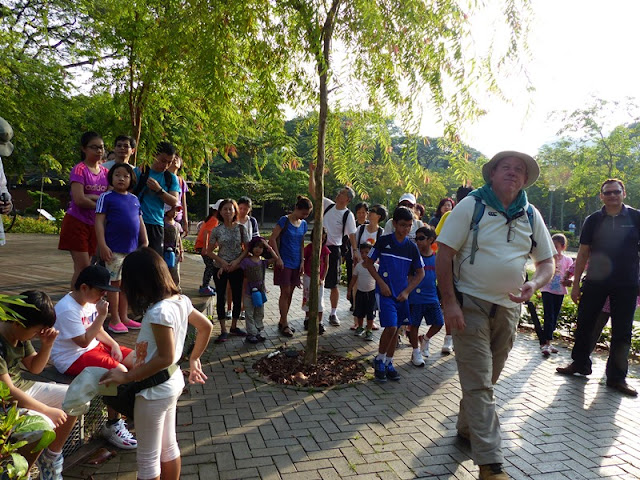By Gloria Seow, Education Committee Chairperson
Sungei Buloh Wetland Reserve, located in the northwestern part of Singapore, is practically synonymous with birdwatching. Other than the multitudes of migratory shorebirds that stopover or overwinter here during the boreal cold season, the sanctuary is a preserve for all things wild – from diminutive praying mantises, mudskippers and tree-climbing crabs to gargantuan monitor lizards and crocodiles. We saw all these and more on 28 November 2015 in a jaunty walk that took us to both the old and new wings of dear Sungei Buloh.
 |
| Our Estuarine Crocodile in the classic pose of a floating log. |
Auntie
Gloria started by introducing the mangrove ecosystem, revealing how these hardy
plants adapt to the daily assault of tidal changes by having leaves that
secrete excess salt, and evolving air-breathing roots (pneumatophores) that
grow above ground in order to thrive in oxygen-starved muddy substrates. The
suspense of trying to spot the Estuarine Crocodile (Crocodylus porosus) for the kids was quickly broken when a parent found
one resting near a mud bank just off the Main Bridge. Our star find was mostly
submerged with only its nose and eyes showing. However, the relatively-clear
waters meant that we could still see most of its body through the binoculars,
and my, what a huge one it was.
Satisfied,
we strode on to the Main Hide where we were greeted with a sizeable flock of curvy-beaked
Whimbrels (Numenius phaeopus), good
numbers of Common Greenshanks (Tringa
nebularia) and Marsh Sandpipers (Tringa
stagnatilis) feeding together, as well as the occasional Little Egret (Egretta garzetta). Four Painted Storks (Mycteria leucocephala) also made an
appearance, and kids learnt that they were part of the Jurong Bird Park’s
free-flying birds programme. Not all birds are migratory or from the Bird Park.
Sungei Buloh also has resident birds present throughout the year – some of us
saw the Black-naped Oriole (Oriolus
chinensis) and we all heard the Collared Kingfisher (Todiramphus chloris) giving off its familiar raucous call.
 |
| The Main Hide served up the Little Egret, Painted Stork and Whimbrel amongst other birds seen. |
As we trod
down the dirt path, we encountered a White-breasted Waterhen (Amaurornis phoenicurus) moving alongside
us, partially hidden in the prop roots of the flanking mangroves. Likewise, we
had several Plantain Squirrels (Callosciurus
notatus) escorting us in our exploration, in turns frolicking alongside and
feasting on fruits. The sharp-eyed Butterfly Boys Daryl Ng and Soh Zhi Bing (both
of whom are butterfly enthusiasts) spotted three Praying Mantises of various
sizes, and even the miniscule Common Redeye (Matapa aria), a skipper with startling red eyes.
 |
| Uncle Tim found us the Lesser Dog-faced Fruit Bat to the delight of the children. |
Malayan
Water Monitors (Varanus salvator) rule
the place, muscular ones that exceed 1.3 m in length. We had them lounging at
the main pond, crossing our paths in an unhurried amble, and even swimming
majestically in a lily-filled waterbody near the Main Bridge. Back at the
Wetland Centre, Uncle Tim had a surprise for the kids. Shushing them first, we then
tip-toed towards a tiny colony of eight Lesser Dog-faced Fruit Bats (Cynopterus brachyotis) hanging upside
down in their diurnal roost on the wooden beams. Many children were delighted
to see a wild bat for the first time. Some were a little spooked by the
dog-like face of this common bat. Uncle Tim said that these mammals come alive
at night, and we can frequently see them swooping around our neighbourhoods at
dusk.
 |
| A basking Giant Mudskipper reveals its blue eyes under the bright sunlight. |
We then
popped into the new extension of Sungei Buloh just across the car park from the
old wing. Unfortunately, the tide was high, so the mud experience area was
flooded and inaccessible. Uncle Tim and Auntie Gloria had on a previous trip spotted
many baby Mangrove Horseshoe Crabs (Carcinoscorpius
rotundicauda) here. Nevertheless, we still saw plenty. There were at least
three species of Mudskippers, with the Giant Mudskipper (Periophthalmodon schlosseri) drawing the most ‘wows’ by virtue of
its size. Tree-climbing Crabs (Episesarma
spp.) were seen scuttling up their mangrove hosts to escape the incoming tide.
Some parents were fascinated with the Sea Holly (Acanthus spp), a shrub that resembles the Christmas Holly. In all,
Sungei Buloh lived up to its reputation of being a prime habitat for all things
wild.




































